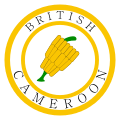British Cameroons
| British Cameroons | |||||||||||
|---|---|---|---|---|---|---|---|---|---|---|---|
| 1922–1961 | |||||||||||
|
Anthem: God Save the King/Queen | |||||||||||
| Status | Mandate of the United Kingdom | ||||||||||
| Capital | Buea | ||||||||||
| Common languages |
English (official) Duaka, Oroko, Grassfields, Fula, Kanuri widely spoken | ||||||||||
| Religion |
Christianity (southern area) Islam (northern area) | ||||||||||
| Historical era | World War I | ||||||||||
• Kamerun partitioned | July 20 1922 | ||||||||||
| October 1 1961 | |||||||||||
| Currency | British West Africa pound | ||||||||||
| ISO 3166 code | CM | ||||||||||
| |||||||||||
| Today part of |
| ||||||||||
British Cameroons was a British Mandate territory in British West Africa. Today, the territory forms parts of Northern Nigeria in West Africa and Cameroon in Central Africa.
History
The area of present-day Cameroon was claimed by Germany as a protectorate during the "Scramble for Africa" at the end of the 19th century.
League of Nations Mandate
During World War I, it was occupied by British, French and Belgian troops, and a later League of Nations Mandate to Great Britain and France by the League of Nations in 1922. The French mandate was known as Cameroun and the British territory was administered as two areas, Northern Cameroons and Southern Cameroons. Northern Cameroons consisted of two non-contiguous sections, divided by a point where the Nigerian and Cameroun borders met. In the 1930s, most of the white population consisted of Germans with Nazi sympathies; they were interned in British camps starting in June 1940. The native population of 400,000 showed little interest in volunteering for the British forces; only 3,500 men did so.[1]
Trust territory
When the League of Nations ceased to exist in 1946, most of the mandate territories were reclassified as UN trust territories, henceforth administered through the UN Trusteeship Council. The object of trusteeship was to prepare the lands for eventual independence. The United Nations approved the Trusteeship Agreements for British Cameroons to be governed by Britain on 6 December 1946.
Independence
French Cameroun became independent, as Cameroun or Cameroon, in January 1960, and Nigeria was scheduled for independence later that same year, which raised question of what to do with the British territory. After some discussion (which had been going on since 1959), a plebiscite was agreed to, and held on 11 February 1961. The Muslim-majority Northern area opted for union with Nigeria, and the Southern area voted to join Cameroon.[2]
Northern Cameroons became the Sardauna Province of Northern Nigeria[3] on 31 May 1961, while Southern Cameroons became West Cameroon, a constituent state of the Federal Republic of Cameroon later that year on 1 October 1961.
Governors
See also
References
- ↑ I.C.B Dear, ed, The Oxford Companion to World War II (1995) p 163
- ↑ Nohlen, D, Krennerich, M & Thibaut, B (1999) Elections in Africa: A data handbook, p177 ISBN 0-19-829645-2
- ↑ Parties and Politics in Northern Nigeria, Routlege, 1968, page 155
External links
![]()


.svg.png)